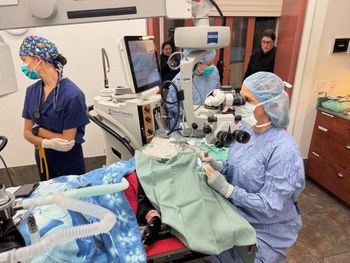
Image Quiz: Can you name that ophthalmologic condition?
Check out these photos from veterinary ophthalmologist Clara Williams, then see if you can identify which disease process is to blame.
Think you know eyes? Clara Williams, DVM, MS, DACVO, of BluePearl Veterinary Partners in Waltham, Massachusetts, certainly does. Examine the images that follow, choose the answer you think fits best, then click to the next page to see if you're right.
What's going on with these patients' eyes?
Canine patient (all images courtesy of Dr. Clara Williams, BluePearl Veterinary Partners).
Feline patient.
A. Multiple intraocular melanomas
B. Multiple free-floating uveal cysts and nuclear sclerosis
C. Unidentified intraocular brown bubbles
D. Aqueous flare and uveitis
Correct answer:
B. Multiple free-floating uveal cysts and nuclear sclerosis
Uveal cysts are fluid-filled, ovoid to spherical structures often seen floating inside the eye in front of the pupil or resting at the bottom of the anterior chamber. The cysts originate from the posterior pigmented epithelium of the iris or ciliary body. Iris cysts are usually of no clinical significance. Sometimes they remain attached and can be seen behind the pupil. If a cyst is densely pigmented and solitary, it must be differentiated from a pigmented tumor.
Iris cysts are common in Boston terriers, Great Danes and golden retrievers. Deflated cysts appear as patches of pigment adherent to the corneal endothelium. Ciliary body cysts in golden retrievers and Great Danes have been associated with glaucoma (elevated intraocular pressure). Iris cysts in cats are thick-walled, darkly pigmented and attached to the pupillary margin. These cases are frequently misdiagnosed as intraocular melanomas.
The condition pictured is …
A. Conjunctival foreign body
B. Unusual "cherry eye"
C. Third eyelid neoplasia
D. Third eyelid cartilage eversion
Correct answer:
D. Third eyelid cartilage eversion
The third eyelid arises as a fold from the ventromedial aspect of the conjunctiva; it is mobile and can cover the entire anterior face of the cornea. A T-shaped hyaline cartilage reinforces the body of the third eyelid. The column of the T curves around the inferomedial aspect of the globe and is surrounded by a seromucous gland. The free edge is concave, stiffened by the cartilage crossbar, to accommodate to the shape of the cornea.
Some breeds such as Saint Bernards, Great Danes and Newfoundlands are predisposed to eversion of the third eyelid cartilage. It is believed to occur due to different growth speeds in the palpebral and bulbar aspects of the cartilage, which then develops a scroll or a bent. Clinical signs are evident (conjunctival hyperemia, increased discharge). The condition affects proper dispersion of the tear film over the cornea.
Surgical correction by either removal of the abnormal portion of the cartilage or cauterization treatment can be performed by a veterinary ophthalmologist.
What's going on with this cat's eye?
A. Normal brown feline iris
B. Feline diffuse iris melanoma
C. Iris nevus (freckles)
D. Iris hyperpigmentation secondary to chronic uveitis
Correct answer:
B. Feline diffuse iris melanoma
The owners notice slow changes in the iris coloration over months or even years. On examination the eye is painless and the iris appears to have diffuse or multifocal hyperpigmentation. The iris melanocytes may proliferate secondary to chronic inflammation or age in a benign or malignant pattern. Pigmented cells from the iris freely exfoliate and may be evident in the intraocular fluid (aqueous humor) circulating out of the eye and into the bloodstream. This suggests that a tumor in the eye can spread to other body organs (metastasize).
Most cases of iris melanosis (so named because the proliferating cells are assumed to be nonmalignant) do not undergo malignant changes to melanoma. A cat with progressive iris melanosis is more likely to develop secondary glaucoma from infiltration and obstruction of the drainage angle than the cat is to develop distant metastasis. However, malignant transformation is always a possibility, with a risk of metastasis and guarded prognosis.
Cats with pigmented iris lesions should be closely monitored. Consultation with or referral to a veterinary ophthalmologist is strongly recommended.
The condition pictured is …
A. Corneal foreign body
B. Indolent corneal ulcer
C. Melting corneal ulcer (corneal collagenolysis)
D. Superficial noncomplicated corneal ulcer
Correct answer:
C. Melting corneal ulcer (corneal collagenolysis)
The key here is the collagenolytic corneal stroma attached to the cotton 4x4.
This condition occurs when a corneal ulcer gets infected by bacteria and the corneal tissue become malacic or “gelatinous.” It appears as if the cornea is literally “melting.” Bacteria such as Pseudomonas aeruginosa, Streptococcus beta hemolyticus and inflammatory cells produce enzymes that attack the collagen fibers of the stroma, causing its breakage (lysis). This process is known as collagenolysis or “melting.” Clinical signs of a stromal abscess include increased tearing, severe ocular pain and redness. The cornea is cloudy, with whitish to yellow discoloration, and looks like melting gelatin.
A melting corneal ulcer requires strong and frequent topical antibiotic therapy supported by systemic antibiotic and analgesic therapy. Preferably the patient should be admitted to the hospital. Response to treatment depends on individual cases and aggressiveness of the condition. Consultation with or referral to a veterinary ophthalmologist is recommended.
Newsletter
From exam room tips to practice management insights, get trusted veterinary news delivered straight to your inbox—subscribe to dvm360.




